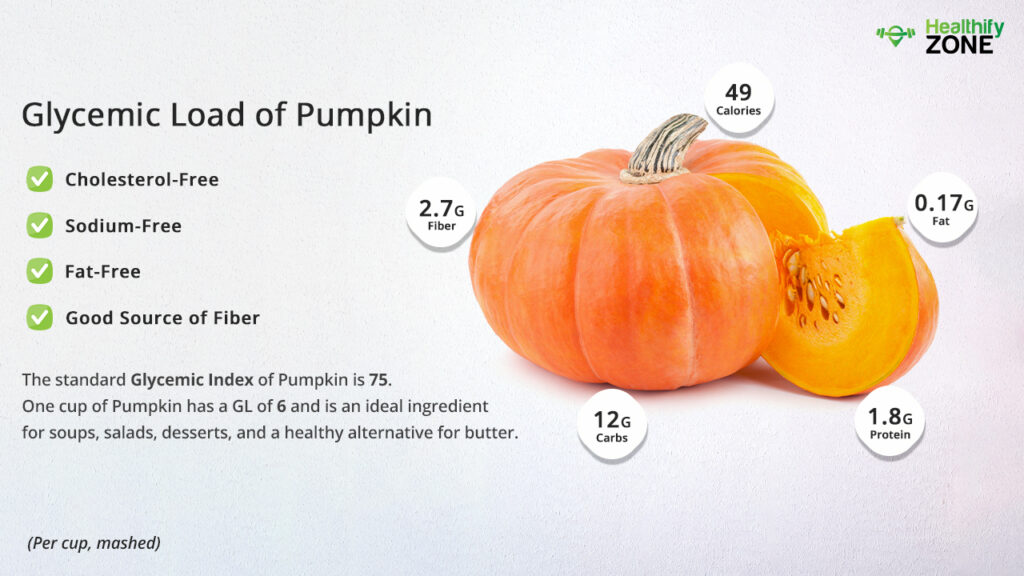The level of carbohydrates present in food with the rapidity with which it increases the blood sugar levels is Glycemic Load. The Glycemic Index is a simple way of making good diet choices. It compares alternate sources of nutrients according to your blood glucose levels. Glucose results in a higher blood glucose response compared to fructose.
A variant of squash, Pumpkin is plump and orange and has various health benefits to offer. It is highly nutrient-dense and can be used in soups, salads, desserts, and also as an alternative for butter. Pumpkins are rather low in calories but very rich in nutrients. The International Glycemic Index measures that the GI of pumpkin is 75.

Pumpkin is versatile and delicious, and it comprises healthy nutrients like
- Vitamins A, C,E ,B-6
- Riboflavin
- Potassium
- Copper
- Manganese
- Thiamine
- Folate
- Pantothenic Acid
- Niacine
- Iron
- Magnesium
- Phosphorous
How to Calculate Glycemic Load of Pumpkin?
The standard Glycemic index of pumpkin is 75. The high glycemic index of the fruit helps in reducing the risks related to cardiovascular diseases. If we want to talk about diet, the key to prevent diabetes or any chronic illness is to distribute the carbohydrate consumption content throughout the day and manage the sugar levels in the body correctly— A bowl of stir fried veggies is something which you can always have, and pumpkin cab is a great addition.

The Formula/Procedure For Calculation of Glycemic Index of the Pumpkin :
GL = GI * carbs / 100
where
- GL – glycemic load;
- GI – glycemic index;
- and carbs – the amount of carbohydrates in the portion.
| SL.NO | PUMPKIN BY WEIGHT IN (g) | GLYCEMIC LOAD |
| 1. | 100 g of Pumpkin | 5.3 (low) |
| 2. | 250 g of Pumpkin | 13.25 (medium) |
| 3. | 500 g of Pumpkin | 26.5 (high) |
| 4. | 1 Kg of Pumpkin | 53 (very high) |
| 5. | One Whole Pumpkin (2 Kg) | 106 (very high) |
| 6. | 1 Cup of Pumpkin | 6 (low) |
Is Pumpkin Safe to Consume If You Have Diabetes?
The common perception is that including pumpkins in your diet can help control diabetes and blood sugar levels. Research shows that the plant compounds from pumpkin have the potential to limit type 2 diabetes. Given their impact on blood sugar levels, scientists are trying to rework pumpkins into antidiabetic medications. As a diabetic patient, you can include about 100 g of pumpkin in one serving. Given its low GL, it will not cause a sudden rise in your blood sugar levels.
Can I Eat Pumpkin During a Fat-Loss Diet?
Pumpkin is nutrient-dense, so you can eat it during a strict fat-loss diet. If you are looking for good results, you should avoid having more than 250 g of pumpkin per serving. One cup of pumpkin will have more than 90% water.

- A 250g serving of pumpkin has a GL of 13.25 which is in the permissible levels.
- A whole pumpkin is something which shoud not be eaten if you are on a fat-loss diet.
Can I Eat Pumpkin During a Low-Carbohydrate Diet?
You can eat pumpkin during a strict low-carb diet. However, you must be careful with the portion size you consume. We suggest you not consume more than 200 g of pumpkin per servings.
Is Pumpkin High in Sugar?
A cup of pumpkin has 94% water. 100 g of pumpkin has 7g carbs and 2.8 g sugar. It is particularly low in sugar and a great source of all the nutrients. Also, it is a weight loss-friendly food, allowing you to consume this more than other carbs. However, you must be mindful of your portions.